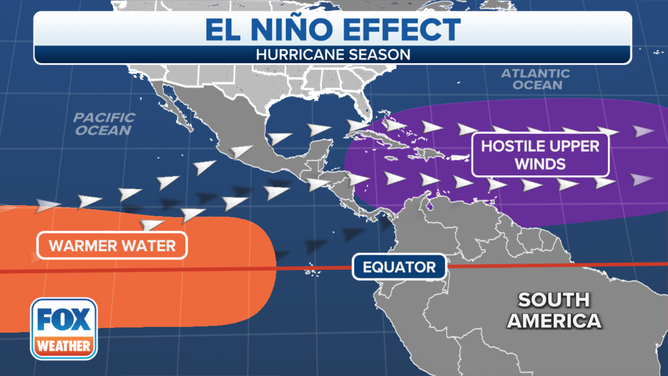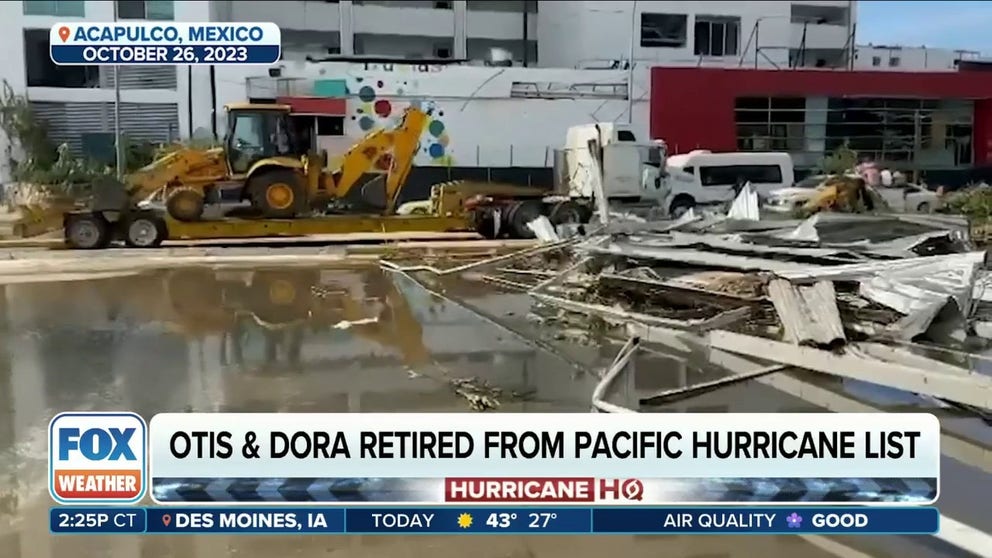El Nino vs. La Nina: Which sees more hurricane name retirements?
The World Meteorological Organization maintains naming lists for several basins across the globe. When a cyclone results in significant destruction or loss of life, its name is retired. La Niña events generally happen more frequently but are less intense than El Niños.
Hurricane names Dora and Otis retired
The WMO voted to retire North Eastern Pacific hurricane names Dora and Otis. For the first time since 2014, the committee did not retire any Atlantic names.
Every year, the World Meteorological Organization meets to discuss seasonal impacts and decide whether any cyclone names in the Eastern Pacific or Atlantic basins warrant retirement.
Retirements happen when cyclones result in significant destruction or loss of life and are often some of the most notorious hurricanes on record.
Storm names such as Andrew, Dorian, Harvey, Irma and Opal have all been retired, but there are some underlying patterns as to when to expect impactful hurricanes. It all comes down to what is known as the El Niño-Southern Oscillation (ENSO).
The ENSO is a climate pattern that involves changing water temperatures in the Central and Eastern Pacific. There are three statuses of the ENSO: La Niña, neutral and El Niño.
La Niña events generally happen more frequently but are less intense than El Niños. Naturally, there have been more hurricanes during these events, but there have been some notable outcomes.

Significantly warmer water in the key equatorial belt typically correlates with limited hurricane development.
(FOX Weather)
7 FACTS TO KNOW ABOUT HURRICANES
When an El Niño event has controlled global weather patterns, such as during the recent 2023 hurricane season, the Pacific sees its most retirements. Nearly 60% occurred during this warm phase of the ENSO.
The climate pattern also produces the least amount of retirements in the Atlantic basin.
What was experienced during the 2023 season coincides with historical retirement data, which has been running since the 1950s.
Two hurricane names – Dora and Otis – were retired from the Eastern Pacific naming list, while zero happened in the Atlantic. That was the first time since 2014 that there wasn’t a retirement in the Atlantic basin.
On the other side of the spectrum, La Niña events are known to produce the highest number of retirements in the Atlantic, with only a few reported in the Pacific.
The little-known neutral stage, which is sometimes referred to as La Nada, is nothing to sneeze at. It resulted in nearly just as many retirements in the Atlantic when compared to La Niña.
HURRICANE NAMES DORA, OTIS RETIRED FROM PACIFIC LIST AFTER DEADLY WRATH
Just because an El Niño or La Niña might be in control doesn’t mean that a basin is guaranteed to see a storm name retired. Many elements must align to create a highly impactful storm.
In the Eastern and Central Pacific, storms must be brought northward in the right area to avoid cool water and strike at maximum intensity.
Hawaii only accounts for two of the retirements, with Mexico leading the way with most of the others.
In the Atlantic basin, more land masses are exposed to tropical trouble, meaning that the threats of impacts are naturally higher.
During the 2005 season, five names were retired from the list of 21 names. These included the names Katrina, Rita, Stan, Dennis and Wilma, which all occurred in either the Caribbean or Gulf of Mexico.
Naming lists are repeated every seven years. Once a name is retired, it is replaced by the WMO so that it can never be used in the basin again to identify a cyclone.




